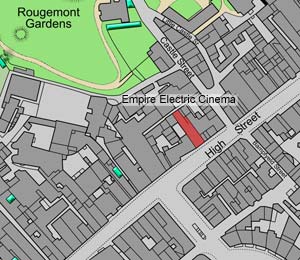
Empire Electric Theatre
Next to St Lawrence Church, at 248 High Street
Page updated 1st January 2014
 1910 - 1937
1910 - 1937
Up until 1910, most cinemas were converted halls, or small theatres. However, the danger of fire from the flammable nitrate film stock was always a danger, and the Cinematograph Act, 1909, was passed, forcing existing venues to make substantial changes to comply with the regulations. The act also encouraged the conversion of suitable shops into purpose built cinemas. The Empire Electric in Exeter was one such venue.
The minutes of the City Council contained the following entry:
"The proprietors of the Empire Electric Theatre in High Street, having applied for a license under the Cinematograph Act, 1909, your Committee inspected the premises on 16th August, 1910, and the City Surveyor and City Electrical Engineer having certified that the buildings and apparatus are constructed and fixed in accordance with the regulations of the Secretary of State, the Committee granted a license subject to compliance with the Council’s conditions, the license to expire on the 31st December, 1910."
On 18th August 1910, the Empire Electric opened, in Wilson's Restaurant, formerly noted for its steak and chips at 1/6 (one and sixpence). The owners were the Bournemouth, Exeter and Plymouth Bioscope Theatre Ltd, who installed Mr R Burgess as the manager and Mr Wensley the electrician and engineer. In later years, the cinema was run by Frank S Cochran as the Exeter Cinematograph Co Ltd.
Mr H E Farmer of Hickton & Farmer of Birmingham was the architect. He created a new frontage to what was an ordinary shop. The auditorium was only 19 feet wide, 97 ft long and 20ft high, and lined with tapestries making it seem more like a tunnel than a film hall. It could seat a maximum of 230 patrons, on a raked floor with the latest tip-up seats, upholstered in Barry cloth. The two entrances were on each side of the screen to separate, the fire-risk, projection equipment from the main means of escape, although this could degrade the picture with light from the door. In the days when the film stock was explosively dangerous, an iron safety curtain could be rolled in to separate the projection box from the auditorium. The projection equipment was designed to expose no more than 6 inches of film, to reduce the possibility of combustion.
The walls were hung with tapestries while the fibrous plaster screen was flanked by flower alcoves lit with tube lights. There were a large number of fresh air inlets, in the roof, with a fan changing the air through tubes.
In the entrance, there was a large globe, showing Asia, Africa, and Australia, supported by two winged cupids, lit in ruby and white. Over the entrance was the inscription "You know one half of the world, we show you the other".
One of the first films to be shown was "Danish Dragoons on Manoeuvres," to selected guests including city officials. The next week Faust an early gramophone talkie was shown, although the system was not often used due to poor volume and it becoming unsynchronised from the film on the screen. The chief projectionist, Mr H P Mears, NAGO, from London, was responsible for introducing the 'singing pictures' , and two early examples were "Let's all go down the Strand" and the "Soldier's Song". Later, the same year, the Empire was advertising continuous shows from 2 pm to 10.30 pm with prices of 3d, 6d and 1 shilling. A young pianist known as Miss 'L' would sit for eight hour sessions, accompanying the flickering images on the screen.
The cinema did not initially advertise their programme in the local newspapers, but by 1912, the papers would cover the programme, if it was relevant to national events. Thus, this appeared in the Flying Post just after the Titanic disaster.
" A sober note is struck by the programme at the Electric Theatre this week. There is a series of scenes showing some of the Titanic’s survivors prior to and after their rescue, and an elaborate set depicts the work of bringing the sunken American battleship Maine to the surface and its final committal to deep water."
Cinema was very popular with children, and in May 1912, the Empire Electric was forced to discontinue child discounts after six o’clock, as they were taking up seating for adults.
Fire in the Projection Box
Despite all the efforts to prevent fire in the projection box, an incident in August 1916 cut short a performance. When a reel of film was being wound off, a spark from the carbon light lit some other exposed film causing a fierce blaze. The iron shield that separated the projection box from the auditorium dropped into position, isolating the fire. There was no panic among the large audience in the cinema at the time, and the building was quickly evacuated. The Fire Brigade was summoned, who soon extinguished the fire. The damage was estimated at £50.
The theatre was occasionally used for private shows, and in 1929 "A Devonshire Idyll" produced and written by Mrs. Simmonds, of Cowick Barton, Exeter, for the Exeter Amateur Film Association, was screened at the cinema.
It closed in August 1937 and the building was destroyed in the May 1942 blitz.
Source: Exeter Flying Poast, Western Times and Exeter and Plymouth Gazette, article by Alex Rankin on the Bill Douglas Centre website at exeter.ac.uk/bdc
 The Empire Electric Theatre.
The Empire Electric Theatre. The Empire Electric Theatre in the High Street. St Lawrence Church is alongside..
The Empire Electric Theatre in the High Street. St Lawrence Church is alongside..
│ Top of Page │